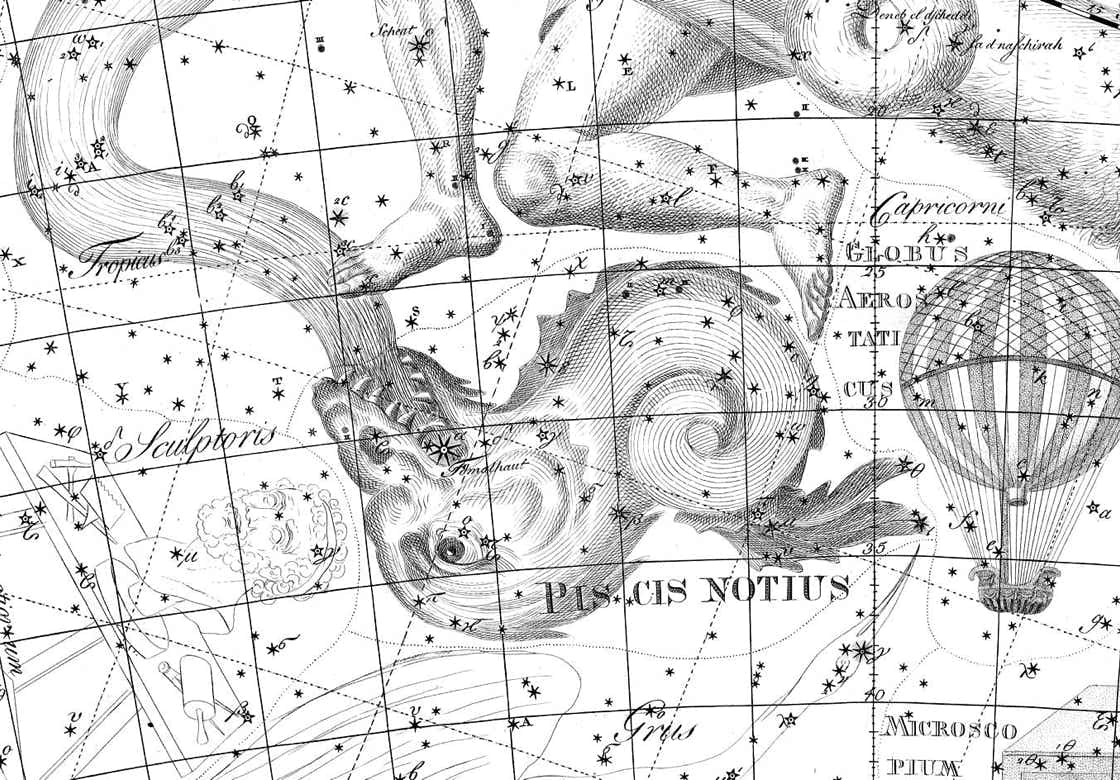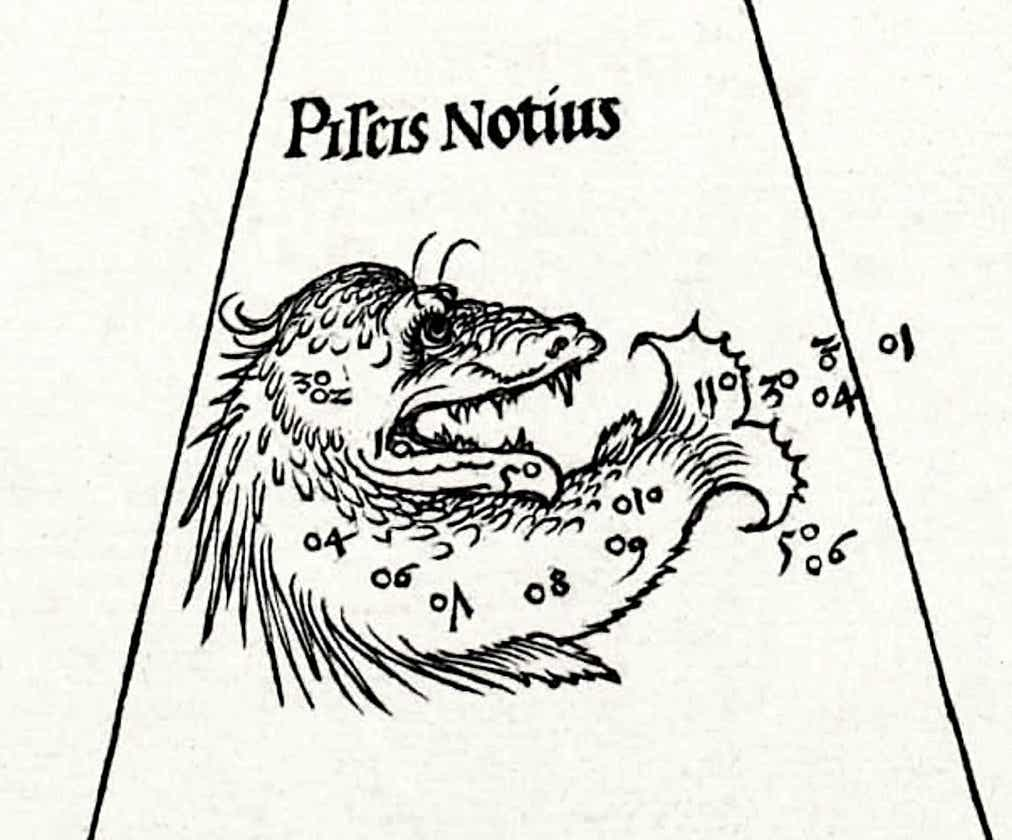
Genitive: Piscis Austrini
Abbreviation: PsA
Size ranking: 60th
Origin: One of the 48 Greek constellations listed by Ptolemy in the Almagest
Greek name: Ἰχθύς Νότιος (Ichthys Notios)
Eratosthenes called this the Great Fish and said that it was the parent of the two smaller fish of the zodiacal constellation Pisces. Like Pisces, its mythology has a Middle Eastern setting that reveals its Babylonian origin.
According to the brief account of Eratosthenes, the Syrian fertility goddess Derceto (the Greek name for Atargatis) is supposed to have fallen into a lake at Bambyce near the river Euphrates in northern Syria, and was saved by a large fish. Hyginus says, in repetition of his note on Pisces, that as a result of this the Syrians do not eat fish but they worship the images of fish as gods. All the accounts of this constellation’s mythology are disappointingly sketchy.
Bambyce later became known to the Greeks as Hieropolis (meaning ‘sacred city’), now called Manbij. Other classical sources tell us that temples of Atargatis contained ponds of sacred fish. The goddess was said to punish those who ate fish by making them ill, but her priests safely ate fish in a theophagic ritual.
According to the Greek writer Diodorus Siculus (1st century BC), Derceto deliberately threw herself into a lake at Ascalon in Palestine as a suicide bid in shame for a love affair with a young Syrian, Caystrus, by whom she bore a daughter, Semiramis. Derceto killed her lover and abandoned her child, who was brought up by doves and later became queen of Babylon. In the lake, Derceto was turned into a mermaid, half woman, half fish.
Piscis Austrinus, called Piscis Notius on Chart XVI of Johann Bode’s Uranographia (1801), is shown lying on its back and drinking water flowing from the urn of Aquarius. In its mouth is the bright star Fomalhaut. Behind its tail lies the now-obsolete constellation of Globus Aerostaticus, the hot-air balloon.
The southern fish was the final constellation in Ptolemy’s catalogue in the Almagest. He listed it under the name Ἰχθύς Νότιος (Ichthys Notios). A common Latin alternative was Piscis Notius, used by Plancius, Bayer, Hevelius, and Bode (above), while Lacaille called it Piscis Australis, a name that was widely used up to the time that the IAU standardized the constellation names in 1922. Edmond Halley, though, preferred the alternative form Piscis Austrinus on his southern star chart of 1678 and this version, with the added authority of Flamsteed, Argelander, and Heis, eventually prevailed.[note]
Fomalhaut and other stars of Piscis Austrinus
Piscis Austrinus is more noticeable in the sky than the zodiacal Pisces because it contains the first-magnitude star Fomalhaut. This name comes from the Arabic fam al-ḥūt meaning ‘fish’s mouth’, which is where Ptolemy described it as lying. In the sky the fish is shown drinking the water flowing from the jar of Aquarius, a strange thing for a fish to do. The flow of water ends at Fomalhaut, which Ptolemy regarded as being common to Aquarius and Piscis Austrinus. Bedouin Arabs visualized Fomalhaut and Achernar (in Eridanus) as a pair of ostriches. The name Fomalhaut is sometimes mis-spelled ‘Formalhaut’.
In the Almagest, Ptolemy listed six additional stars in this area that did not form part of Piscis Austrinus; these are now assigned to the modern figure of Microscopium. In addition, when the 12 new southern constellations of Keyser and de Houtman were invented at the end of the 16th century, the star that Ptolemy placed at the tip of the fish’s tail was appropriated for use as the head of the new constellation Grus, the crane; it is now known as Gamma Gruis. Bayer and others straightened out the tail of Piscis Austrinus so that it did not overlap with the head of Grus.
Chinese associations
Chinese astronomers called Fomalhaut Beiluo shimen, the gate to the encampment of Yulinjun, the Royal Guards, a large constellation to the north of it. Epsilon and Lambda Piscis Austrini, along with another two or three fainter members of Piscis Austrinus, were part of Yulinjun, most of which was in Aquarius. Delta Piscis Austrini was Tiangang, ‘celestial net’, representing tent-making facilities for the military camp.
Gamma Piscis Austrini plus three other stars, possibly including Gamma and Lambda Gruis, formed Baijiu, a bowl or tub, said by some to be for waste disposal. Ten stars including Mu, Theta, and Iota Piscis Austrini formed Tianqian, ‘celestial money’, interpreted variously as coins or paper money; one interpretation says it was paper money to be burnt in Baijiu to appease ghostly spirits.
© Ian Ridpath. All rights reserved

Lacaille gave the name of the southern fish as Piscis Australis on his southern planisphere of 1763. On his first planisphere of 1756, where names were in French, he called it Poisson Austral.
AUSTRINUS, AUSTRALIS, AUSTRALE
Why are three different adjectives used for the southern
constellations Corona Australis, Piscis Austrinus, and Triangulum Australe, when they all mean ‘southern’? The answer is to do with the characteristics of Latin:
• Austrinus is a masculine adjective in Latin and must be matched to a masculine noun, in this case Piscis.
• Australis is an adjective that can accompany either masculine or feminine nouns; in the sky it is paired with the feminine noun Corona to give Corona Australis.
• Australe is a neuter adjective that accompanies a neuter noun, hence Triangulum Australe is the correct form.
Ptolemy’s six ‘unformed’ stars lying outside Piscis Austrinus, numbered from 1 to 6 in the order they were listed in the Almagest, seen at right on Albrecht Dürer’s celestial chart of 1515. They are now part of Lacaille’s invention Microscopium. Ptolemy allocated 12 stars to Piscis Austrinus itself, including Fomalhaut (star number 1), but Dürer’s chart somehow missed one out. The star here labelled 11, on the end of the fish’s tail, was Ptolemy’s 12th star; it was later incorporated into the constellation Grus and is now known as Gamma Gruis. Dürer positioned the head of the fish strangely so that its mouth is facing away from the stream of water coming from the urn of Aquarius. The constellation is drawn in mirror image, as on a celestial globe, and south is at the top.




